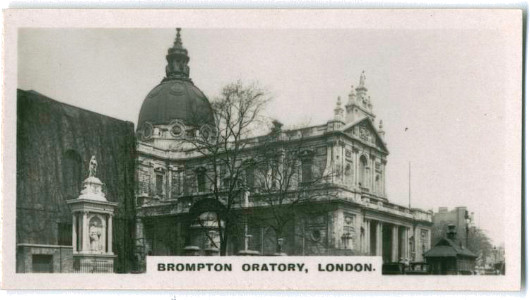Brompton Oratory
About Andrew Cusack
 Writer, web designer, etc.; born in New York; educated in Argentina, Scotland, and South Africa; now based in London.
Writer, web designer, etc.; born in New York; educated in Argentina, Scotland, and South Africa; now based in London. read more
News
Blogs
Reviews & Periodicals
Arts & Design
World
France
Mitteleuropa
Knickerbockers
Argentina
The Levant
Africa
Cape of Good Hope
Netherlands
Scandinavia
Québec
India
Muscovy
Germany
Academica
Saturday: Day of Fasting & Prayer for Peace in Syria
Given the urgent situation, please see the following from the Fathers of the London (Brompton) Oratory:
Day of Fasting and Prayer for Peace in Syria
This is in response to the following call to fasting and penance issued by His Holiness Pope Francis:
“On 7 September, in Saint Peter’s Square, here, from 19:00 until 24:00, we will gather in prayer and in a spirit of penance, invoking God’s great gift of peace upon the beloved nation of Syria and upon each situation of conflict and violence around the world. Humanity needs to see these gestures of peace and to hear words of hope and peace! I ask all the local churches, in addition to fasting, that they gather to pray for this intention.”
The London Oratory invites you to join the Holy Father in prayer for this urgent intention.
6.45pm-11.00pm Exposition of the Blessed Sacrament, the Little Oratory
The Lady Altar
The Oratory Church of the Immaculate Heart of Mary,
Brompton Road, London
In the south transept of the Brompton Oratory is the altar dedicated to the Blessed Virgin, perhaps the finest altar in the entire church. It is a favourite place for getting in a few prayers and offering a candle or two or three or four. At the end of Solemn Vespers & Benediction on Sunday afternoon (above) it is where the Prayer for England is said and the Marian antiphon sung.
The Lady Altar was designed and built in 1693 by Francesco Corbarelli of Florence and his sons Domenico and Antonio and for nearly two centuries stood in the Chapel of the Rosary in the Church of St Dominic in Brescia. That church was demolished in 1883, and the London Congregation of the Oratory purchased the altar two years beforehand for £1,550.
The statue of Our Lady of Victories holding the Holy Child had previously stood in the old Oratory church in King William Street, and the central space of the reredos was slightly modified to house it. The Old and New Worlds are represented in the flanking statues, which are of St Pius V and St Rose of Lima — both by the Venetian late-baroque sculptor Orazio Marinali. The statues of St Dominic and St Catherine of Siena which now rest in niches facing the altar were previously united to it, and are by the Tyrolean Thomas Ruer.
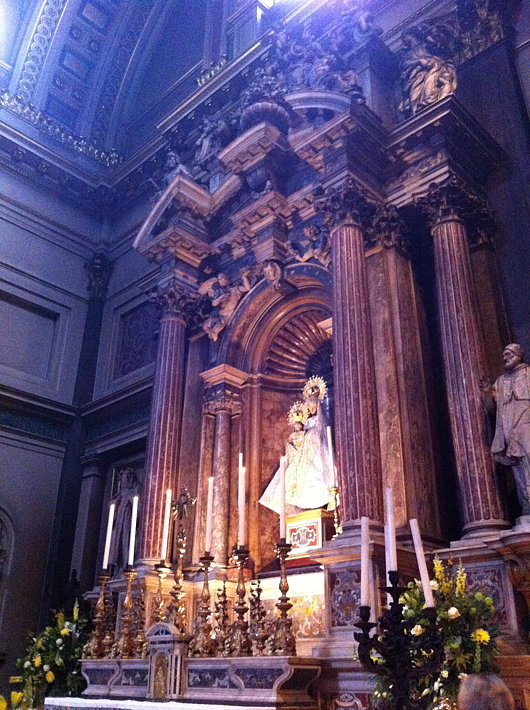
From the provost
The Provost of the Brompton Oratory, Fr Julian Large, warns Catholics not to let their attitude to the Pope be determined by the media
Shortly before his abdication, Pope Emeritus Benedict XVI delivered an address to the clergy of the diocese of Rome. He reflected on his experiences as an expert at the Second Vatican Council in the 1960s, and on that Council’s effects on the life of the Church. He spoke mysteriously of a contrast between the Council of the Fathers, meaning the proceedings that actually took place around the Pope in the Vatican, and what he called, a ‘virtual Council’, or a ‘Council of the media’. According to Pope Benedict, the real Council was firmly rooted in Catholic doctrine and aimed at renewing the Faith, while the ‘virtual Council’ as presented to the world through the media had a completely different, political, objective. Pope Benedict explained: “this Council [the ‘virtual’ one] created many calamities, so many problems, so much misery, in reality. Seminaries closed, convents closed, the liturgy was trivialised.” Pope Benedict even lamented that this ‘virtual Council’ was stronger than the official Council itself.
Whether or not we agree with this interpretation of the hermeneutics of the Second Vatican Council, we must acknowledge that the media in the world today exerts a formidable power over the information that ultimately determines how we think and live. (more…)
The Lenten Evening Oratory
Brompton Road, SW7 2RP
Lent 2013
Evening Oratory
with the Fathers
in the tradition of St. Philip Neri
WEDNESDAYS at 6.30pm
20.Feb.2013 – Little Oratory
The Oratory Choir
The Three Lenten Tasks: tasks for all the year
27.Feb.2013 – Little Oratory
London Oratory School Schola
Adversaries of the Spiritual Life: The Flesh, The World, The Devil
6.Mar.2013 – Little Oratory
The Oratory Choir
Our Lord speaks to His followers before the Passion
13.Mar.2013 – The Church
Holy Hour during 40 Hours Exposition (Quarant’Ore)
20.Mar.2013 – Little Oratory
Oratory Junior Choir
Our Lady’s Dolours (texts from Stabat Mater)
27.Mar.2013 – The Church
Tenebrae in Cena Domini
The Oratory as It Was Built
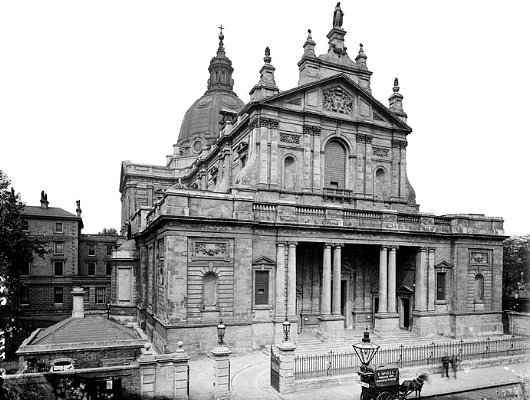
Since we explored Brompton Oratory as it might have been, here is the Oratory as it was built. The façade were finally completed in 1893 to a design by George Sherrin, with the dome following in 1894-95 by Sherrin’s assistant E. A. Rickards. How is the Oratory as depicted above different from the Oratory today? The fence and gates were replaced with a curved design at some date unknown to me, perhaps in response to a road-widening scheme.
Brompton Oratory as It Might Have Been
Failed Entries of the 1878 London Oratory Architectural Competition
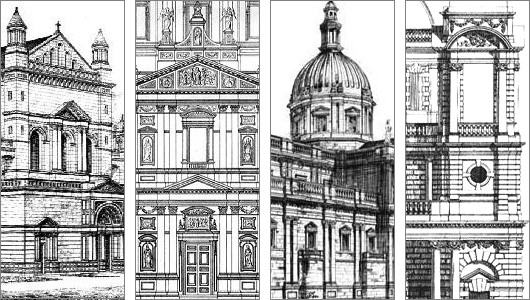
ARCHITECTURAL COMPETITIONS have always fascinated me because they give us the opportunity to glance at multiple executions for a single concept, to see different minds solve a “problem” with their own particular formulas and theorems. The designs of many of the world’s prominent buildings were chosen by competition, perhaps the Palace of Westminster — Britain’s Houses of Parliament — is most famous among them. When the Hungarian Parliament held a competition to design a grand palace to house the body, it found the top three prize designs so compelling that it built the first-prize design as parliament and the second and third places as government ministries nearby. To my surprise, I have only ever come across one book which adequately surveyed the subject of competitive architecture, Hilde de Haan’s Architects in Competition: International Architectural Competitions of the Last 200 Years. Most of the contests covered in the book are, naturally, for government buildings of national importance — private clients usually have a very firm idea of what they want and choose an architect accordingly.
One building not mentioned in the book but nonetheless very dear to me (and no doubt to many readers of this little corner of the web) is the Church of the Immaculate Heart of Mary of the Congregation of the London Oratory, more popularly known to friend and foe alike as the Brompton Oratory. It was the first church in Britain in which I ever heard mass, the summer after kindergarten when I was still but a tiny, blond-haired whippersnapper, in the midst of my first visit ever to the Old World, and the Oratory made quite a strong impression upon my young mind. It is usually one of my very first ports of call whenever I am in the capital, and I once even managed to slip in having just arrived at Heathrow while making my way to King’s Cross and the train to Scotland.
The Brompton Oratory is known for having good priests, traditional liturgy, and beautiful architecture. The final design was by one Herbert Gribble, but there was quite a bit of to-ing and fro-ing before Gribble was selected. The temporary church which had been erected on the site had been condemned by one critic as “almost contemptible” in its exterior design. In 1874, the Congregation of the Oratory (which is to say, the priests) put out an appeal for funds towards the construction of a permanent church. The 15th Duke of Norfolk obliged with £20,000 to get the ball rolling, and the next year a design by F. W. Moody and James Fergusson was agreed upon in principle. But the Reverend Fathers soon began to get creative and hatch ideas and contact other architects and very soon it was claimed that there were as many counter-proposals as there were priests of the Oratory, and perhaps more. A pack of clerics supported a suggested design by Herbert Gribble, but no accord could be reached among the Congregation as a whole.
In January 1878, then, it was announced that a competition would take place to decide the design of the permanent church of the London Oratorians. First prize was £200, with £75 for the runner-up. All entries had to meet the certain requirements drawn up by the Congregation. The style was to be “that of the Italian Renaissance”. The sanctuary, at least sixty feet deep, must be “the most important part of the Church. … Especially the altar and tabernacle should stand out as visibly the great object of the whole Church.” The minimum width of the nave was fifty feet, and maximum length 175 feet. Subsidiary chapels must be “distinct chambers”, not merely side altars. One aspect not mentioned was the projected execution costs of the designs — “an omission criticized by architectural journalists and disgruntled competitors,” the London Survey tells us, “whose designs called for expenditure ranging from £35,000 to £200,000”.
Over thirty entries were submitted to the competition, and Alfred Waterhouse was commissioned by the Fathers to provide comment on the submissions. Significantly, George Gilbert Scott, Jr. submitted a design, though I haven’t been able to get my hands on any depictions of it. Waterhouse praised it as “of no ordinary merit. … I feel that it is impossible to speak too highly of its beauty, its quiet dignity, its absence of all vulgarity and its concentration of effect around the high altar.” (more…)
Diary
I have been spending the past few days in a flat at the corner of Holland Park Avenue and Portland Road, in this verdant corner of the capital. The flat is clean, capacious, and handsome, but terribly modern. Indeed, it is so modern that it will soon be old; it will not exhibit the old age of the time-honoured and true, but rather the tawdry oldness of what had only recently been new. Pedantic students of interior design will study photos of it and discern “2008 I’d say… no! 2009!” But for now, it is still new, still fresh, and so, like a tomato fresh for the plucking, we will enjoy it while its moment is precisely appropriate.
Until now, I hadn’t much knowledge of this part of London, but find it a happy place to be in August. The weather has been mild and kind, and I spent part of the afternoon reading de Maistre — the St. Petersburg Dialogues — in the formal garden in Holland Park. The avenue itself is tree-lined, or rather tree-engulfed, such is the plentiful shade, and has a small selection of cafés: the Paul boulangerie which is becoming omnipresent, and the Valerie patisserie, both chains. Cyrano, at No. 108 Holland Park Avenue, is much preferred, and I decamped there for a light breakfast with a copy of the Scotsman from the local newsstand (the one on Ladbroke Grove, rather than the smaller one by the tube stop) while avoiding the miserable Irish cleaning lady who returns the modern flat to its pristine whiteness every Thursday morning.
Then to the Royal Academy, for the Waterhouse show. What an interesting artist! His earlier works so precise in detail and, for lack of a better word, academic. Yet in his later pieces, you can find a certain willingness to obfuscate, perhaps an admission that reality is not quite so precise and that the most accurate portrayal of reality requires a few lines to be blurred. Faces, and indeed all forms, remain clear throughout, but the architectural coldness of the earlier works on display gradually evolves to a more fluid depiction of Greek mythos and Keatsian tales. Waterhouse can vary in his details from the almost photographic to verging on impressionism in a single painting. Was that his intention? It was certainly the result.
My viewing companion — an old university friend — and I agreed that throughout all the themes portrayed by the artist one can’t help but feel an overwhelming Victorian-ness. Is this ex post facto because we know Waterhouse to be an High Victorian artist, or is there actually some inherent quality in the works that calls to mind that era? Very difficult to say, but those in London should not miss this exhibition of a popular yet under-appreciated artist — the Jack Vettriano of his day.
Who is in London in August anyhow? The text messages sent out, and their replies promptly received. “I’m in Geneva! Will be in Luxembourg next week if you’re on the continent.” I am not and will not be on the continent. “I have been unexpectedly called to Africa.” Well I’ve just come from there, though not the Sudan thank God. “You’re welcome to come to Gozo between the 5th and 15th for a pleasant, quiet holiday.” I will have returned to New York by then, alas. “Am up north in Lancashire; you’re welcome to come and visit, sample our recusant history!” Just haven’t got the time, alas.
But while many have escaped for the month, many yet remain. An afternoon drink at Rafe’s, with Fr. Rupert and Alex Williams. The Carlton is being refitted, so it was drinks at the East India Club instead with another university friend, during which we concur that office jobs are the absolute pits and we should have studied agriculture with the country girls at Cirencester rather than getting tawdry MAs in Scotland. There is no greater affirmation of the consequences of original sin than the omnipresence of the 9-to-5 office job.
Astute observers of this little corner of the web (if indeed we can use the plural for such a subset of the earth’s population) will recall an incident over two years ago now in which a certain Jack Russell terrier became rather more involved with my lower leg than I had envisioned was ideal. The dog, which goes by the name of Cicio Stinkiman, had noticed me playing with the only seeing-eye-dog in Scotland that knows how to genuflect and resented the attention I was paying to the bitch, to whom he obviously professed some attachment, ran up, and bit me in the calf.
You can imagine my surprise when I learnt that the beast in question is actually now not only living in London but actually residing in the Oratory. Indeed I saw the beast from a distance while waiting on Brompton Road for the Friday evening mass last week. His owner graduated from university (in Scotland, like all the wisest people) two years ago now but his mother banned poor Cicio Stinkiman from the German palace he might otherwise call home, perhaps informed along the voluptuous grapevines of Europe of the horrendous incident in which the beast had taken an unwelcome interest in my lower leg.
I am being far too unfair to poor Cicio, for he did apologise, and looked up at me with terribly apologetic eyes. Admittedly, that might’ve been because his master stood nearby holding a rolled-up copy of the Catholic Herald most threateningly. Still, pity the poor ignorant beasts. They have no conscience, and thus no real malice. Only we humans, with the freedom we abuse so easily, can claim that dubious achievement.
Our Cardinal at the Oratory
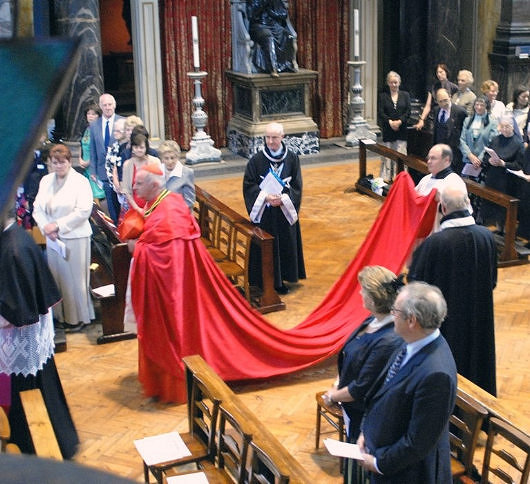
His Eminence Keith Patrick O’Brien, Cardinal Archbishop of St Andrews & Edinburgh, at the Brompton Oratory for the Feast of St. John the Baptist this year.
(From the NLM)
Boers, Peter Simple, and Pith Helmets
Sometimes something rather interesting is right under your nose and you never even notice it. I read the Catholic Herald — the premier Catholic newspaper in the English-speaking world — every week and have been reading it since university days, but I have rarely read Stuart Reid’s “Charterhouse” column on the back page. A few recent perusals have exposed my foolishness for neglecting it. They are presented for your reading here.
(Of course, there has never been a columnist as brilliant as Peter Simple, whose works we have shown you in a series of installments.)
Charterhouse
by STUART REID
Everyone needs a secular hero or two, and one of mine is Rian Malan. In the Sunday Times at the weekend he had a very nice diary, in which he said that he liked Jacob Zuma, because the president-elect of South Africa had “old-fashioned views on stuff like law and order”.
Malan also said that it was a good time to be a Boer: “…as South Africa staggers towards its destiny, it’s white Left-liberals who are wailing about our government’s shortcomings. The Boers never expected any better, so we are generally immune to the gloom.”
The diary made my heart go out, once again, to the Boers. They are brave, honest, hard-working, courteous, old-fashioned and often God-fearing, with a weakness for the bottle. Plus they were on the right side in the Boer War and their women – sometimes their men too – are beautiful.
The Rosary Crusade
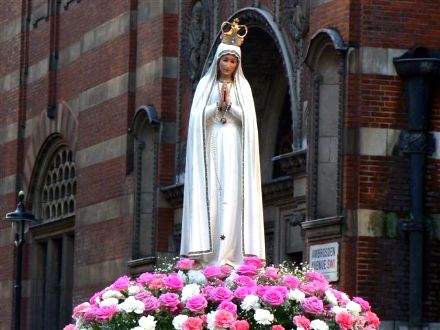
THE BLESSED VIRGIN HAS quite the legion of followers at her beck and call, and a good many battalions (perhaps even a regiment?) turned up on October 14 for the annual Rosary Crusade for the reparation of sins. The event began with a procession from Westminster Cathedral near Victoria Station, through the streets of London, to Brompton Oratory in Kensington. A statue of Our Lady was borne aloft by members of the Catholic Police Guild the whole way to the Oratory, where Benediction was held. We bring you these photos, taken by, amongst others, Matt Doyle, and Ken Simpson, all of which we found via ‘Joee Blogs‘, a Catholic medical student in London.
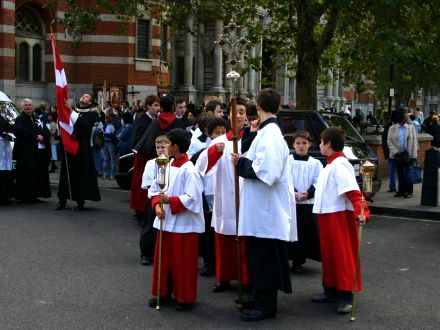
A Visit to London Town
Part the First: In Which Cusack Takes to the Rails
The great St Andrean, Russell Kirk, despised the automobile, calling it ‘the mechanical Jacobin’. I am not altogether inclined to agree but the late Dr. Kirk and I are in accordance with one another over the pleasures of travelling by rail. It is seven hours direct from Leuchars Junction to London King’s Cross, but a pleasant journey nonetheless.
We departed Leuchars on time at 9:30am and stopped at Edinburgh Waverley at 10:32. From the north, the train crawls into the city beside the massive dark crag of Edinburgh Castle, after which the spires of the Mound come into view. By 11:30 we were in England, passing by Berwick-upon-Tweed, the municipality which has the strange situation of being a Scottish town but on the English side of the border. Just two minutes before midday, 300 miles north of London near a town called Acklington I discovered, upon looking outwards from my seat, that the horses of this region have taken to wearing cloaks. Remarkable.
From the route of the railway, the passenger has the advantage of being able to see both Durham Cathedral and York Minster (in southerly succession) and then finally Peterborough Cathedral, which I’ve always thought looks rather awkward. We finally trawled into King’s Cross a few minutes after 4:00pm, and I was slightly cross to see the London Underground ticket machines do not accept Scottish bank notes, forcing me to wait in line and deal with a real, live, terse, and unappreciative human.
Part the Second: In Which Cusack Visits the Travellers Club
Having settled in where I was staying, I scurried off to the Travellers Club on Pall Mall (stopping along the way only to get a prayer in at the Oratory) for the little affair which, in fact, was the reason for my journey down to London. It’s a beautiful club of a not-overwhelming size with a beautiful staircase, the kind of which one feels ought to be ascended slowly and with dignity. (The Drones it is not). The party was held to proclaim the U.K. launch of the New Criterion in the hopes of furthering the renown and appreciation of the greatest cultural review in the English-speaking world in the land which brought forth the very language. We had, I believe, nearly two hundred people in the library of the Travellers Club during the course of the evening, some familiar faces but more often very familiar names to which I can now assign faces. One of the first folks I met was the doctor and writer Anthony Daniels (also known as Theodore Dalrymple) who has just left England to live in France (in the Ardeche, was it?). There were also, among others, the Obituaries editor of the Daily Telegraph (who won’t smoke filtered cigarettes), the Rev. Peter Mullen, social commentator and Chaplain to the Stock Exchange, and the rather charming Paul Dean, Head of English at the Dragon School in Oxford, with whom I enjoyed conversing. Fellow St Andrean Merrie Cave of the Salisbury Review and I discussed how smoking has replaced sex as the ultimate taboo in the eyes of universities today. Roger Scruton couldn’t come, because he’s just moved to Virginia hunt country, of course.
Afterwards, James Panero having highed off to the Athenaeum, Dawn Steeves coralled a number of us into cabs destined for the Windsor Castle pub in Notting Hill where we continued to debate, agree, disagree, digress and whatnot on into the night. Eventually I decided I had consumed enough red wine and dark ale and called it a night myself.
Part the Third: In Which Cusack Enjoys the Company of Old Friends
On the morning of the next day I met Chris C. (St Andrews ’05) for coffee on High Street Kensington. C. and I disserted all the latest news, and I enjoyed hearing about his latest (mis?)adventure before we headed to Nilene Hennessy’s flat to enjoy a pork roast with potatoes. Nilene was out, but after our luncheon we met her and her younger sister Donalyn for more coffee. Donalyn is currently studying veterinary pharmacology.
AC: “So are there any major differences between veterinary pharmacology and human pharmacology?”
DH: “Well, it’s for animals.”
We all tarried a while, but eventually I headed towards my next appointment, amply relayed to yourself in…
Part the Fourth: In Which Cusack Goes A-Churching
A little after 4 o’clock, I met up with Ed Henley, another fairly recent St Andrews graduate, in the narthex of Westminster Cathedral, where he currently lives and works. Shamefully, I had never before visited the Mother Church of Catholic Britain in all its glory. After taking tea in a sort of lounge within the Cathedral complex, he took me on a grand tour of the place. Around the nave, the side chapels, down into the crypt, and even up into the rafters. Interestingly, Ed tells me that there was originally supposed to be a Benedictine congregation at the Cathedral, and strangely enough the monks’ cells were built atop and overlooking the nave. You can see little balconies for each cell hanging off the sides of the nave. Of course, it was a terribly impractical idea, owing to the many, many circular stairs the inhabitant would need to climb to reach his cell, and at any rate such a foundation was never actually started.
The sacristy is massive, and Ed was eager to show off Westminster’s cappe magne. “Even got the winter one,” quoth Ed, “with all the fluff.” Nice dalmatics as well.
The mosaics, at least those which have been completed, are amazing. The Chapel of St Andrew even has a mosaic depiction of the town of St Andrews above the arms of the Marquess of Bute. (A poor view of it can be found here). The majority of the mosaic work is unfinished, and would presumably take years and years, not to mention millions and millions of pounds to complete, however some plans are being drawn up and considered. “We’re rather hoping the Americans will pay for it,” Ed explained. “There’s a tendency for Americans to just sort of pop in one day, fall in love with the place, and donate a few million.” (The American Friends of Westminster Cathedral is a nonprofit 501(c)(3) organization, and thus contributions are tax-deductible for those interested. See here).
I attended the choral vespers in the beautiful Lady Chapel, and stayed for the following Mass in the main sanctuary, which was offered in a resplendently reverent and sacred manner. Westminster Cathedral is a beautiful place, physically ablaze with Christianity, and, like the Church, as yet unfinished. I rather fell for the place and feel obliged to visit it again.
Part the Fifth: In Which the Churching Continues
My last event in London was meeting up with Tori Truett (yes, another St Andrean, but one of the most delightful) that evening for the inaugural meeting of the Brompton Oratory’s youth group (ages 18-35, I think). Frs. Rupert, Julian, and Michael gave brief chats about their hopes for the group and the general shape of future events and then food and drink were enjoyed by all. Met some interesting folks including an Oxford friend of John Lamont, a Canadian from Vancouver, and a chap named Vandenberg (can’t recall his first name) who’s sister just graduated from St Andrews and has ten siblings! Now that’s what I call the Catholic response to the Culture of Death! Someone’s got to outbreed the heathen.
Finale
Back up to Scotland today, though I met with no cloaked members of the equine species on the return journey. A giant rainbow, however, arched across the sky just a bit past Ladybank a few minutes before reaching Leuchars and taking a cab back to St Andrews. A very pleasant journey, and hopefully one that can be made again soon.
Search
Instagram: @andcusack
Click here for my Instagram photos.Most Recent Posts
- Burns Tower April 19, 2024
- Patrick in Parliament March 18, 2024
- Articles of Note: 13 March 2024 March 13, 2024
- Cambridge March 9, 2024
- Taken on Trust March 4, 2024
Most Recent Comments
Book Wishlist
Monthly Archives
Categories

